Fenestration Solutions for Efficiency and Performance
A Sound Experience
Overall, there is growing interest in better sound attenuation as fenestration systems become more effective in controlling thermal performance over large areas. In general, while sound transmission includes both airborne and structure-borne vibration, the STC single-number rating describes only the window assembly's designed ability to resist airborne sound transfer within the frequency range of 125-4000 Hz. STC can be improved by adding air space, mass or isolating materials within the window assembly.
“Today, leading manufacturers are guiding architects to specify STC in their projects,” says REHAU's St. Thomas. “With the typical goal-setting for better STC in the industry, for many window and door products you really need to bump up the glass structure to hit the desired numbers. However there are European window technologies that generally offer a higher baseline STC.” The typical windows in Europe, where uPVC tilt-turn products are commonplace, have such sound-abatement features as compression seals and multipoint locking, St. Thomas adds.
Recent U.S. projects built using these window designs include The Montage in Reno, Nevada, one of the largest adaptive-reuse projects in the sector. The architecture firm Antunovich Associates reimagined the 23-story former Golden Phoenix Hotel and Casino as a mixed-use residential community with 380 living units including loft, penthouse, and pool terrace residences. In the conversion design, one highly marketable feature—floor-to-ceiling windows, incorporated to maximize daylighting—was initially specified as commercial-grade, aluminum-frame systems. Yet the architects and project team saw the benefits of installing uPVC tilt-turn windows and top-of-the-line uPVC doors for energy-saving performance and noteworthy aesthetic appeal.
Like other large adaptive-reuse projects, The Montage offers a number of performance benefits to both occupants and the property owners. Sustainable design aims of the Antunovich Associates team included a substantial long-term reduction in environmental impact and carbon footprint, which the fenestration products would reinforce. In terms of the lifestyle experience for residents, the windows help reduce hot spots and cold spots and they reduce noise infiltration when closed. For opening, the windows can be used either by tilting to create a hopper-type or awning-type opening, which often maximizes effective natural ventilation. In their turn position, the windows basically operate as convenient casement units for Reno's high-altitude, low-rainfall yet low-evapotranspiration climate.
In other climates and settings, improvements to curtain wall, window wall, and storefront systems are opening impressive vistas while also controlling thermal and sound variables. Examples include urban cultural and academic settings as well as transportation hubs, where both noise control and visual transparency are key project aims.
In an example that merges both project types, the architecture firm Architype created an airport visitor center in the natural hilltop landscape of Chiltern Hills at Dunstable Downs in the southeast of England. Commissioned by the local county council and The National Trust, the project was envisaged as a destination for all visitors, not just those arriving or departing by plane. Architype responded with a purpose-designed facility marked by large expanses of curtain wall and an expressive pitched roof that would meet high standards of sustainability. “The development of the center has been designed with a rigorous environmental agenda, with great consideration given to reduction in use of fossil fuel energy and the adoption of a palette of ecologically sound and nontoxic materials,” the firm said in a project statement.
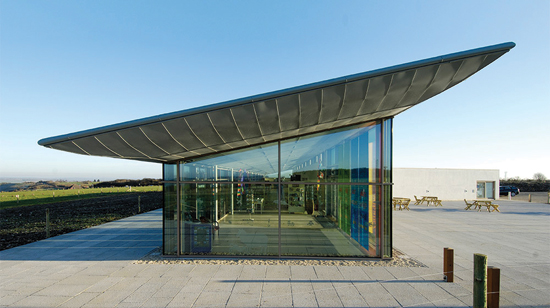
Photo by Leigh Simpson Photography, courtesy of Architype and Menck Windows
The British firm Architype designed an airport visitor center in England using a robust post-and-rail façade with triple glazing to allow copious daylight into the interior while controlling thermal loss and gain.
For the fenestration system, Architype detailed a post-and-rail façade construction with special shapes employing triple glazing with a special tint and coatings. Filigree views of the profiles help form a “harmonious overall appearance” for the modern building, according to the glass façade maker. For visitors, the heavy façade system provides a relatively consistent perimeter temperature for comfort as well as broad views of the hilly green countryside. The architects incorporated a range of green technologies to supplement their effective enclosure design, including a wood chip boiler, rain water recycling, and a novel windcatcher channel that draws air from outdoors into the building through a 295-foot-long underground concrete “earth duct,” according to Architype.
Climate Responsive, Super Insulating
The use of wood, rain, and wind helps give buildings like the Chiltern airport facility a very small carbon footprint, while the glass expanses improve the potential benefits of the sun: chiefly passive solar heating and illumination.
Yet novel fenestration designs also benefit from relatively novel building materials, such as Space Age products like aerogels. While the materials are hardly brand-new, they have been proven to work and have a good track record extending back a decade or more. In fact, the scientist Samuel S. Kistler of Stanford University and the College of the Pacific, Stockton, California, reported on novel laboratory aerogels and “jellies” in the journal Nature back in early 1931. Kistler and collaborators “prepared silica, alumina, nickel tartarate, stannic oxide, tungstic oxide, gelatine, agar, nitrocellulose, cellulose, and egg albumin aerogels,” and remarked that, “the new physical properties developed in the materials are of unusual interest.”
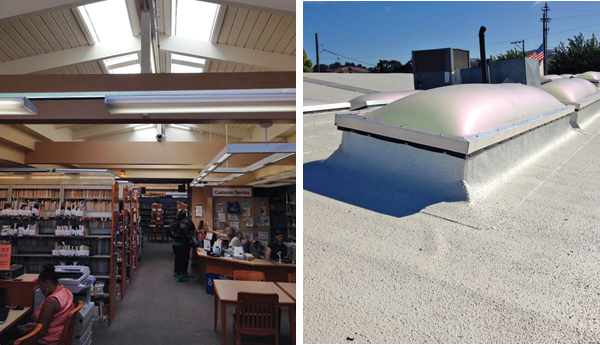
Photos courtesy of Wasco Skylights
A library and fire station in Vallejo, California, achieved Title 24 energy-efficiency compliance with a new roof and aerogel-filled skylights that achieve 92 percent UV blockage but higher daylight levels.
Notice

www.dowcorning.com/construction
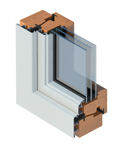
www.menckwindows.com
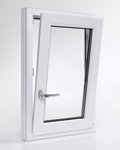
www.na.rehau.com/4500
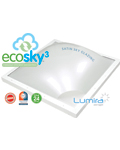
www.wascoskylights.com/ecosky3









